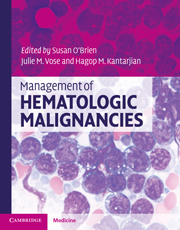Book contents
- Frontmatter
- Contents
- List of contributors
- 1 Molecular pathology of leukemia
- 2 Management of acute myeloid leukemia
- 3 Treatment of acute lymphoblastic leukemia (ALL) in adults
- 4 Chronic myeloid leukemia
- 5 Chronic lymphocytic leukemia/small lymphocytic lymphoma
- 6 Myelodysplastic syndromes (MDS)
- 7 Hairy cell leukemia
- 8 Acute promyelocytic leukemia: pathophysiology and clinical results update
- 9 Myeloproliferative neoplasms
- 10 Monoclonal gammopathy of undetermined significance, smoldering multiple myeloma, and multiple myeloma
- 11 Amyloidosis and other rare plasma cell dyscrasias
- 12 Waldenstrom's macroglobulinemia/lymphoplasmacytic lymphoma
- 13 WHO classification of lymphomas
- 14 Molecular pathology of lymphoma
- 15 International staging and response criteria for lymphomas
- 16 Treatment approach to diffuse large B-cell lymphomas
- 17 Mantle cell lymphoma
- 18 Follicular lymphomas
- 19 Hodgkin lymphoma: epidemiology, diagnosis, and treatment
- 20 Treatment approaches to MALT/marginal zone lymphoma
- 21 Peripheral T-cell lymphomas
- 22 Mycosis fungoides and Sézary syndrome
- 23 Central nervous system lymphoma
- 24 HIV-related lymphomas
- 25 Lymphoblastic lymphoma
- 26 Burkitt lymphoma
- Index
- References
14 - Molecular pathology of lymphoma
Published online by Cambridge University Press: 10 January 2011
- Frontmatter
- Contents
- List of contributors
- 1 Molecular pathology of leukemia
- 2 Management of acute myeloid leukemia
- 3 Treatment of acute lymphoblastic leukemia (ALL) in adults
- 4 Chronic myeloid leukemia
- 5 Chronic lymphocytic leukemia/small lymphocytic lymphoma
- 6 Myelodysplastic syndromes (MDS)
- 7 Hairy cell leukemia
- 8 Acute promyelocytic leukemia: pathophysiology and clinical results update
- 9 Myeloproliferative neoplasms
- 10 Monoclonal gammopathy of undetermined significance, smoldering multiple myeloma, and multiple myeloma
- 11 Amyloidosis and other rare plasma cell dyscrasias
- 12 Waldenstrom's macroglobulinemia/lymphoplasmacytic lymphoma
- 13 WHO classification of lymphomas
- 14 Molecular pathology of lymphoma
- 15 International staging and response criteria for lymphomas
- 16 Treatment approach to diffuse large B-cell lymphomas
- 17 Mantle cell lymphoma
- 18 Follicular lymphomas
- 19 Hodgkin lymphoma: epidemiology, diagnosis, and treatment
- 20 Treatment approaches to MALT/marginal zone lymphoma
- 21 Peripheral T-cell lymphomas
- 22 Mycosis fungoides and Sézary syndrome
- 23 Central nervous system lymphoma
- 24 HIV-related lymphomas
- 25 Lymphoblastic lymphoma
- 26 Burkitt lymphoma
- Index
- References
Summary
Introduction
The non-Hodgkin lymphomas (NHLs) encompass a wide spectrum of disorders with varying clinical and biologic features. The appropriate diagnosis and classification forms the basis of clinical patient management and the choice of treatment protocol. The diagnosis of lymphoma begins by a thorough evaluation of the histologic and cytologic features. However, this is often inadequate for accurate classification as there is often significant overlap between these entities. Immunophenotyping studies, either by flow cytometry or immunohistochemical staining, are often initially done to determine lineage and possibly clonality. Molecular techniques are of increasing practical importance as they provide an additional level of testing. This is particularly useful in cases where the histologic features or the immunophenotypic findings are not conclusive, or the biopsy is small, hampering an accurate assessment. As well, molecular testing can detect specific lymphomas that have distinctive molecular abnormalities. Figure 14.1 describes an algorithm, outlining how ancillary testing can be utilized in the diagnosis of lymphoma.
This chapter attempts to summarize the basic molecular biology, principles of the molecular techniques, common molecular aberrations, and the application of molecular diagnostics as a key ancillary tool in the diagnosis and classification of lymphoma.
IG and TCR gene rearrangements
Human lymphocytes have the ability to specifically recognize millions of different antigens and antigenic epitopes. This is based on the enormous diversity of their antigen-specific receptors, known as immunoglobulin (IG) and T-cell receptor (TCR) molecules. Each single B or T lymphocyte has a distinct IG or TCR and expresses approximately 105 molecules with identical antigen specificity.
- Type
- Chapter
- Information
- Management of Hematologic Malignancies , pp. 257 - 276Publisher: Cambridge University PressPrint publication year: 2010



